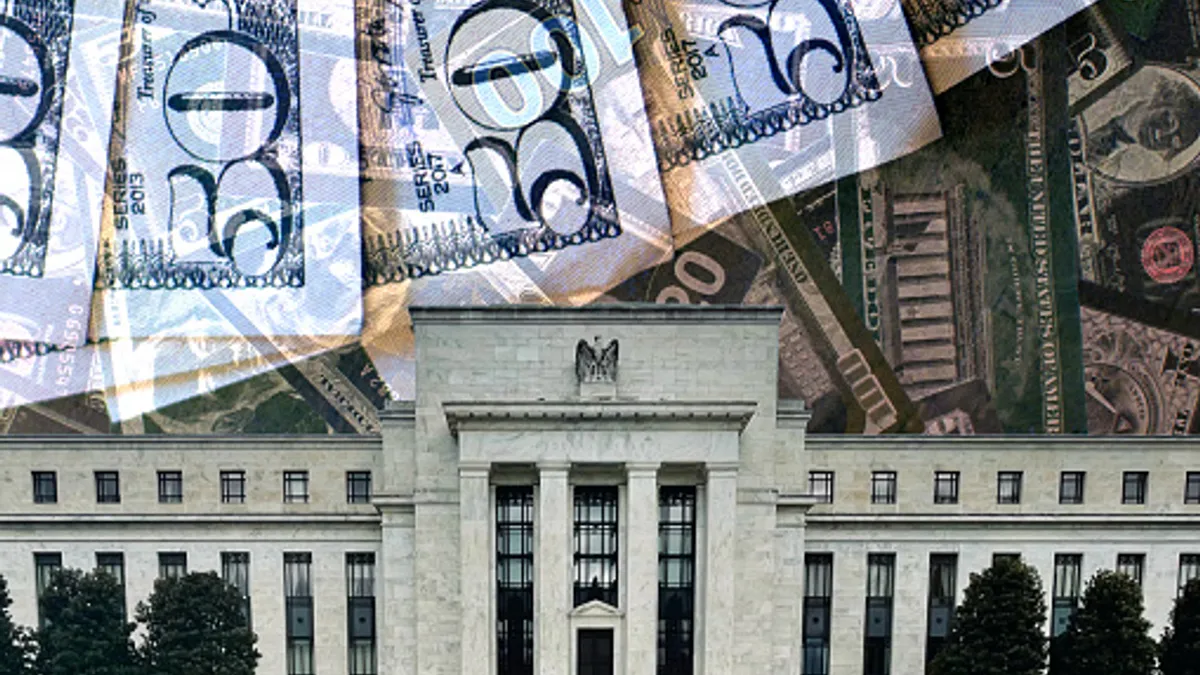Dive Brief:
- Core inflation eased last month to the slowest annual pace since September 2021, prompting bets that the Federal Reserve in May will reverse course on monetary tightening and cut the benchmark interest rate by a quarter point.
- The consumer price index excluding volatile food and energy prices rose at a 4% annual rate in October, slower than forecast and lower than in September and August, the Labor Department said Tuesday.
- Declining gains in every major category of prices except food spurred traders in interest rate futures to set 67% odds that the Fed will cut the main rate by at least a quarter point during a May 1 meeting, according to the CME FedWatch Tool. Traders shifted the probability that the central bank will leave the federal funds rate unchanged at a meeting next month to 100% from 85% on Monday.
Dive Insight:
Slowing price gains in energy, energy services, shelter and commodities such as new and used vehicles signal that the Fed is making progress in achieving its 2% inflation target and will probably forgo another rate hike beyond the current 22-year high, economists and market analysts said.
“The most encouraging data is that all broad indices rose less in October than in September so that inflation is on a downward trajectory,” said Aleksandar Tomic, director of the graduate programs in applied economics and applied analytics at Boston College. “I do not expect the Fed to raise rates again this cycle.”
The yield on the 10-year Treasury note fell nearly 0.2 percentage points Tuesday to 4.448%. The yield is the benchmark for corporate bonds, auto loans, mortgages, student loans and other financing.
“We’ve made a lot of progress on inflation,” Chicago Fed President Austan Goolsbee said after the release of inflation data on Tuesday. “It’s still looking like slow but clear progress on each of the categories” of prices.
During the next six months Goolsbee said he will closely track the trend in rent prices, noting that rents usually lag changes in other prices by as much as a year.
The increase in shelter prices last month slowed to 0.3% from 0.6% but pushed up core CPI more than any other price category, the Labor Department said.
“We’ve seen the beginnings” of an easing in rent prices “but that must continue,” Goolsbee said in response to a question at the Detroit Economic Club.
Fed Chair Jerome Powell this month has also indicated the central bank cannot declare victory in its fight against inflation, noting an erratic decline in price gains over several months.
“We know that ongoing progress toward our 2% goal is not assured — inflation has given us a few head fakes,” Powell said Thursday in a speech. Policymakers “are not confident” that they have raised borrowing costs enough, he said in a speech at the International Monetary Fund.
The Fed since March 2022 has hiked the main interest rate from near zero to a range between 5.25% and 5.5%. Its preferred inflation measure — the core personal consumption expenditures price index — fell in September to 3.7% on an annual basis from 5.5% in September 2022.
“Powell’s commentary at the IMF meetings last week reaffirmed the Fed’s tightening bias with monetary policy,” Ginger Chambless, head of research at JPMorgan Chase Commercial Banking, said in a report.
Fed Vice Chair Philip Jefferson on Tuesday echoed Powell’s concern about the murky outlook on inflation.
When calibrating monetary policy, Fed officials today believe they confront the highest level of uncertainty regarding price pressures in 20 years, Jefferson said in a speech.
Fed policymakers “and central bankers around the globe have been emphasizing the elevated level of uncertainty, especially related to inflation, and the challenge this poses for monetary policy,” he said, noting the difficulty in gauging the economic impact from the pandemic and geopolitical turmoil.
The future course of inflation has become “the dominant source of aggregate economic uncertainty,” Jefferson said.












